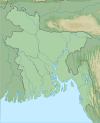Madhupur National Park
Madhupur National Park (Bengali: মধুপুর জাতীয় উদ্যান) is a major and one of the earliest[1] national park in Bangladesh.
| Madhupur National Park | |
|---|---|
IUCN category II (national park) | |
 Madhupur National Park Location in Bangladesh | |
| Location | Tangail District, Dhaka Division, Bangladesh |
| Nearest city | Madhupur |
| Coordinates | 24°45′00″N 90°05′00″E |
| Area | 8436 hectares |
| Established | 1982 |
Description
Madhupur National Park covers an area of 8,436 ha (20,850 acres). The Forest was established as a national park by the Bangladesh government in 1962 but, was officially declared as National park in 1982 under the Bangladesh wildlife (Preservation) Amendment Act of 1947.The park is located at Madhupur Upazila, Tangail District in the North region of the country. It is about 125 kilometres (78 mi) away from Dhaka.The local topography mainly consists of flat topped ridges (Chalas) intrsected by numerous depressions(Baids).[2] The park is easily accessible by the road throughout the year. The park is a famous tourist spot due to the natural and scenic beauty.
Climate
The climate is generally moderate. The temperature rises up to 37 °C in May and drops down to minimum 10 °C in January. The park enjoys tropical Monsoon from June to September every year.The soil is loamy, clay and sandy loam at various places. The altitude rises to 15 m (49 ft)above mean sea level.[2]
Biodiversity
The national park is rich in wildlife and plant diversity.
Flora
The general walk in the forest is easy due to the flat terrain. About 40% of the forest area is covered with Sal (Shorea robusta) trees. Madhupur forests are considered one of the best sal forest in entire Bangladesh. The sal trees grow in association with Dillenia pentagyna, Lagerstroemia parviflora, Adina cordifolia, Miliusa velutina, Lannea grandis, Albizia spp., Bauhinia variegata, Spondias mangifera, Butea frondosa and Barringtonia acutangula. The undergrowth is shrubby which includes Eupatoriun odoratum, Pennisetum setosum, Asparagus racemosus and Rauwolfia serpentina. Plantations of Teak Tectona grandis, Cassia siamea, Morus spp.,Teminalia arjuna and Syzygium cumini were made in the park area.[2] 176 plant species were identified in the park which include 73 tree species, 22 shrub species, 27 climbers, 45 medicinal plants, 8 grasses and 1 palm species.[1]
Human settlement
There is large human habitation inside and along the National park area. Some 4500 Garo tribals were allowed for the settlement inside the park in 1968.in 1989 the human population was about 14,000. Mainly paddy is cultivated in plains and pineapple and cassava is cultivated as a commercial crop on higher lands.
References
- Banglapedia. "Madhupur National Park". www.en.banglapedia.org. Retrieved 7 December 2019.
- Green, Michael J.B. (1990). IUCN directory SouthAsian Protected Areas (PDF) (First ed.). Cambridge, UK: IUCN Publication. p. 20. ISBN 2-8317-0030-2. Retrieved 5 December 2019.
